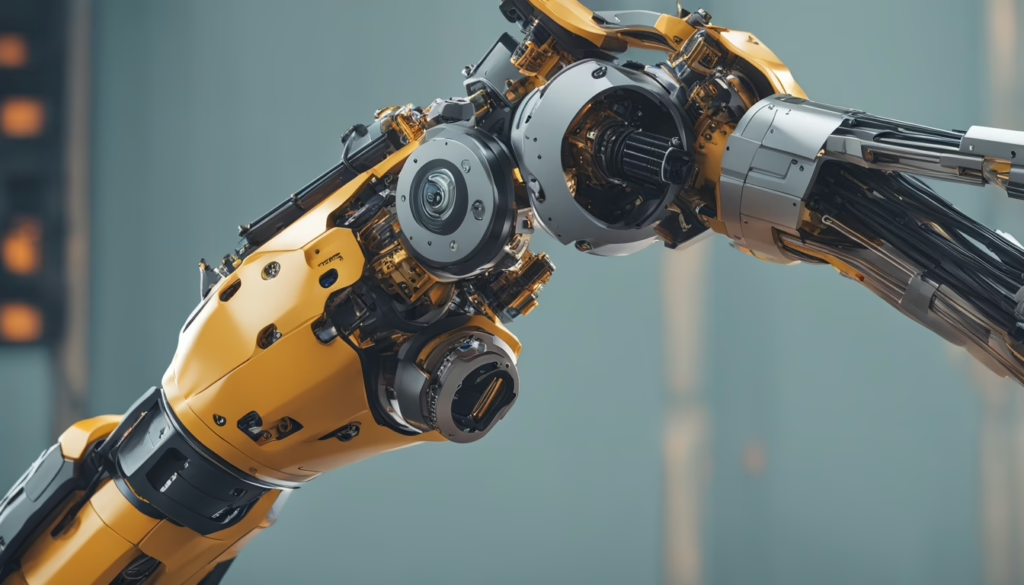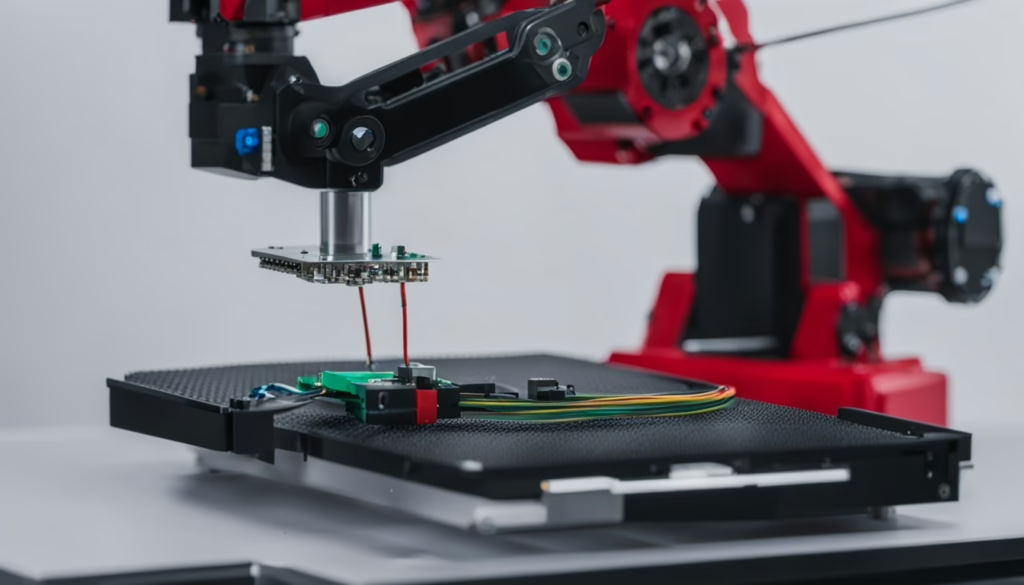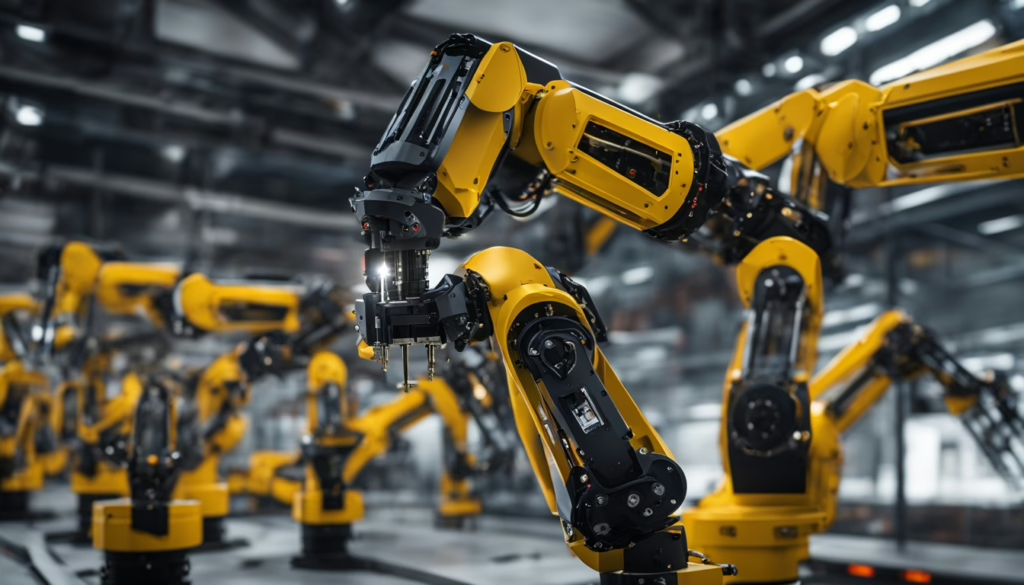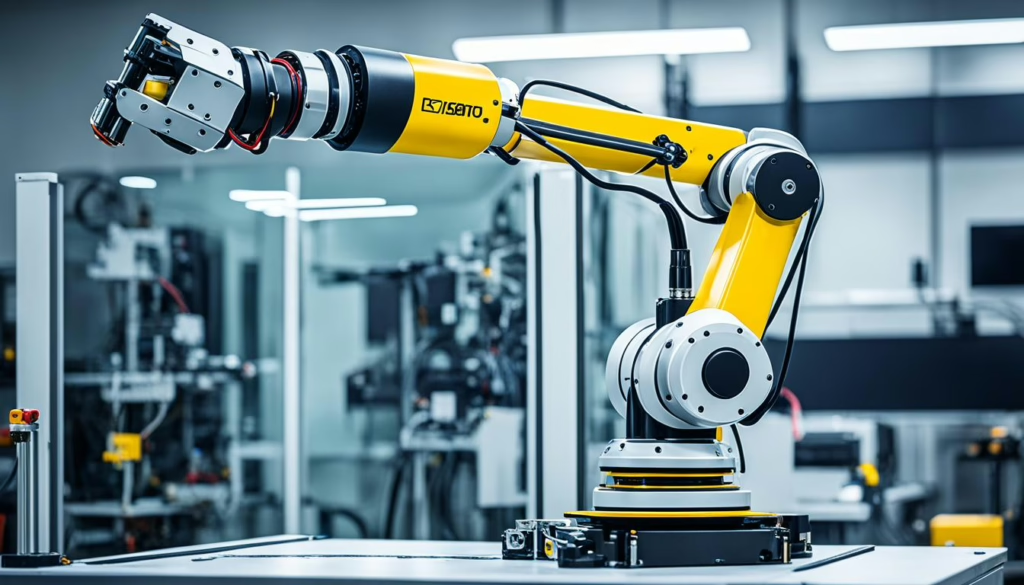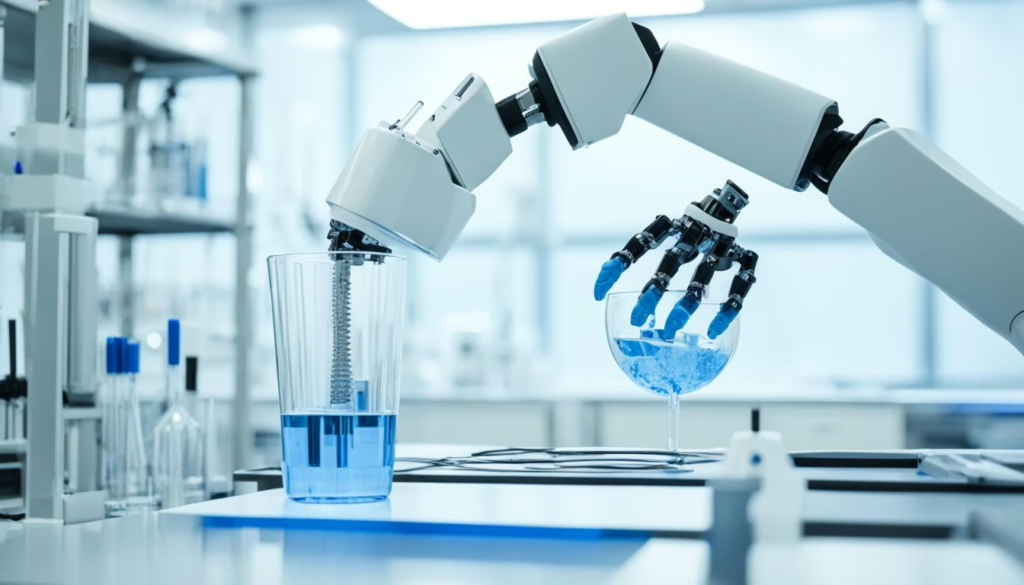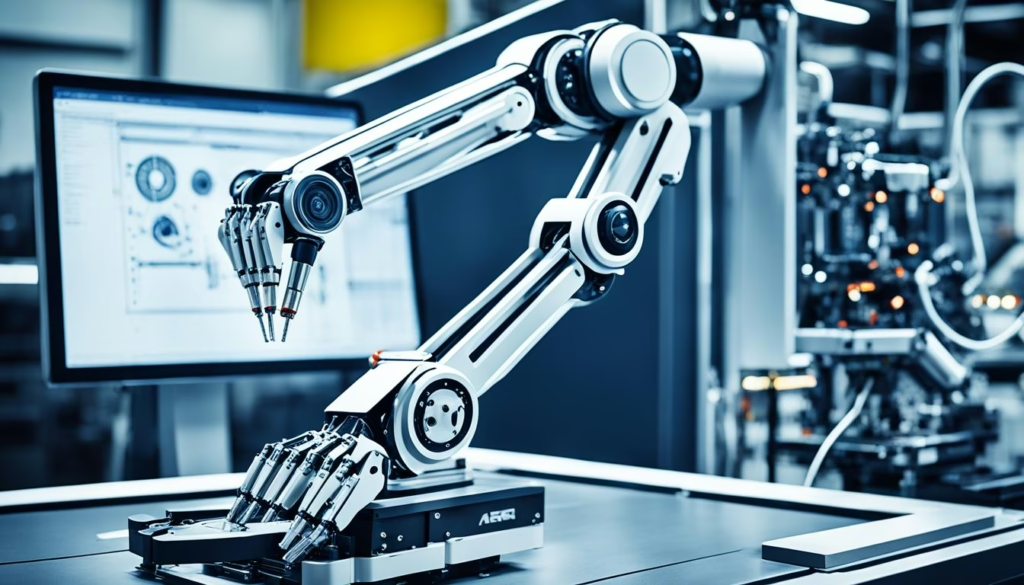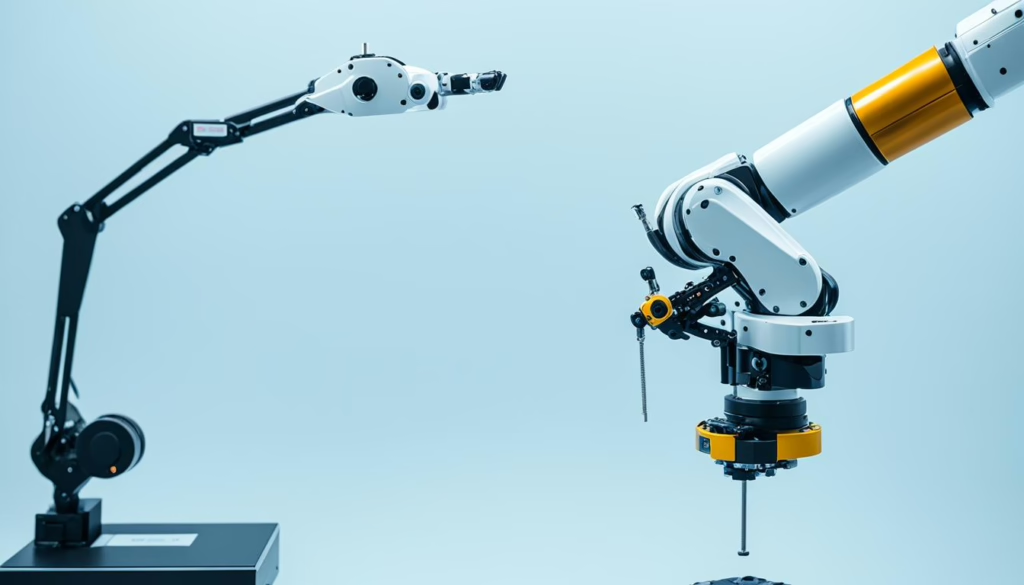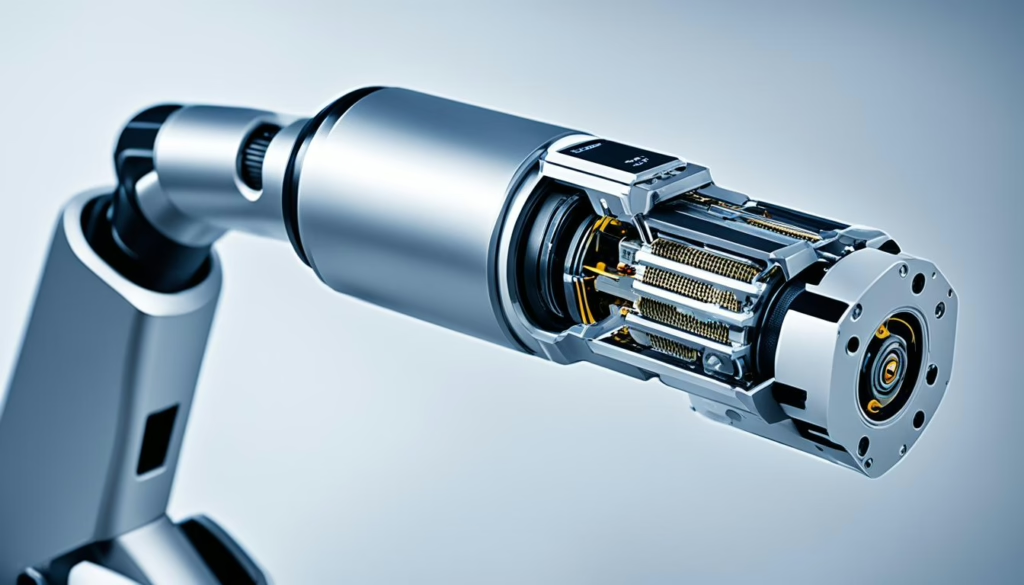Robotic arm precision sensors are changing the game in advanced robotic technology and automation. They are key to making robots work better and more accurately. These sensors make sure robotic arms can do their jobs with great precision and reliability.
XJCSENSOR is leading the way in making these sensors better for automation systems. We’ll dive into how precision is vital in robotic technology. We’ll also explore the new innovations that are pushing this field forward.
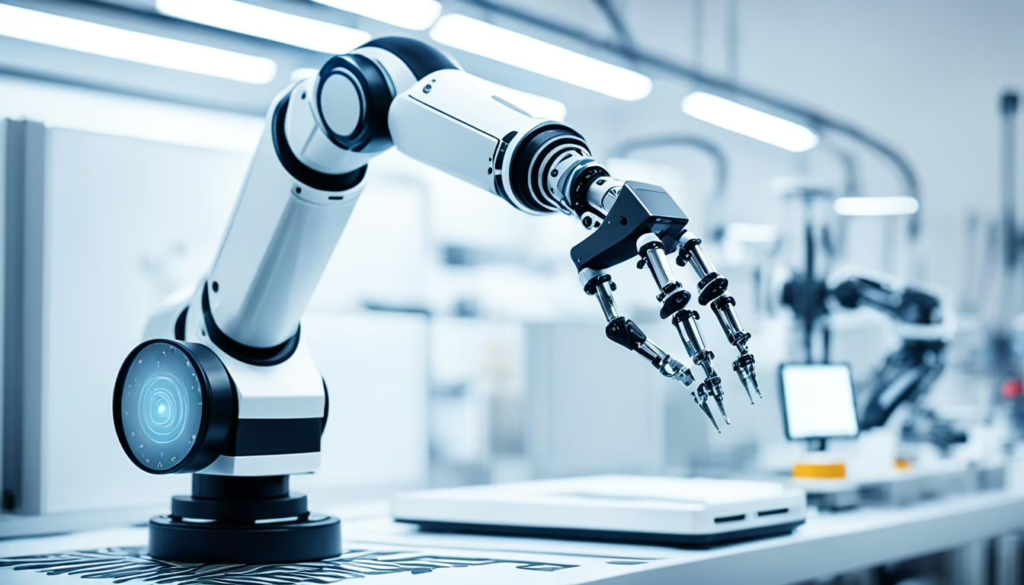
Key Takeaways
- Understanding the critical role of robotic arm precision sensors in automation.
- Insights into how advanced robotic arm technology enhances precision control.
- The importance of accuracy and efficiency in robotic arm systems.
- Introduction to XJCSENSOR’s innovative solutions for precision control.
- An overview of how sensors are revolutionizing various industries.
Introduction to Robotic Arm Sensors
Robotic arm sensors are key in today’s automation and industry. They make robots work better and more precisely. These sensors can sense things like light, sound, temperature, and pressure. This lets robots interact with their world more effectively.
By adding sensors to robotic arms, industries get better performance and reliability. This is a big step forward.
What are Robotic Arm Sensors?
Robotic arm sensors are special devices that send data to control systems. They tell a robot what’s around it. There are many types, like proximity, ultrasonic, and pressure sensors.
Their main job is to collect and send information. This helps robotic arms make smart choices during work. For example, in making things and checking quality, these sensors are very important. They help keep things accurate and efficient.
The Importance of Precision in Robotic Arm Technology
Robotic arm sensors are crucial for tasks that need to be done just right. They help robotic arms do tricky tasks, like putting small parts together, without mistakes. This is very important in fields like aerospace, healthcare, and making things automatically.
Experts at XJCSENSOR say these sensors are all about precise measurements and fast work. This makes robotic systems work better.
New tech in robot arm sensors is opening up new uses in many areas. It makes things run smoother and cuts down on breakdowns. This means robots are more reliable and strong. For more info on the different sensors in robotic arms, check out sensors in robotics. It talks about how these sensors are key to precise automation.
Types of Sensors Used in Robotic Arms
Modern robotic arms use many sensors for precise control and efficient work. These smart sensors help these systems work accurately and adapt in different tasks.
Motion Sensors for Robotic Arms
Motion sensors are key in controlling robotic arms’ movements. They track position and speed changes for smooth actions. This makes the robotic arm perform complex tasks with great precision and consistency.
Pressure Sensors for Robotic Arms
Pressure sensors are crucial for robotic arms in tasks needing gentle handling or steady force. They measure the force used, helping the system adjust its grip and movements. This is vital for tasks like assembly or medical robotics that require careful handling.
Force Sensors for Robotic Arms
Force sensors check the force the robotic arm uses or feels. They give feedback to keep the arm working right and prevent damage. With a force sensor, the robot can keep the right force, making it safer and more efficient.
| Sensor Type | Function | Key Benefits |
|---|---|---|
| Motion Sensor | Monitors arm position and speed | High precision, smooth operation |
| Pressure Sensor | Measures exertion levels during tasks | Delicate handling, consistent force application |
| Force Sensor | Determines exerted force on objects | Enhanced safety, optimal force control |
Robotic Arm Position Sensors
In the world of robotics, robotic arm position sensors are key for keeping the arm’s movements precise. They give important feedback. This feedback helps the robotic arm move just right, which is key for doing complex tasks accurately.
Precision sensor technology in these sensors can spot even the tiniest changes in position. This is vital in places like assembly lines, surgery robots, and automated warehouses. These sensors keep an eye on the arm’s position and adjust it as needed. This keeps the arm on the right path and in the right spot.
Let’s look at the main features and benefits of robotic arm position sensors:
- High Precision Feedback: Gives real-time data to prevent mistakes in position.
- Integration Capabilities: Can be easily added to different robotic systems to improve their work.
- Robust Performance: Made to work well in many places, from cleanrooms to industrial areas.
These sensors are really important for tasks that need a lot of accuracy. They give precise feedback, which leads to better performance and reliability in many areas. This makes them a key part of robotics.
How Robotic Arm Sensors Improve Control Systems
In robotics, sensors are key to better control systems. They make robots more accurate and efficient, which is vital for many tasks. By using advanced sensors, robots can do complex jobs with great precision.
Enhancing Accuracy in Robotics
Getting things right is crucial for robots. Sensors help by tracking movement and position. This lets them make tiny adjustments on the fly.
This means robots can do tricky tasks with fewer mistakes. For example, in surgery, sensors help robots move exactly as needed. This lowers the chance of mistakes and helps patients.
Improving Efficiency with Advanced Sensors
Robots need to work fast and accurately in many fields. Advanced sensors help by giving detailed info on things like force and motion. This info lets robots adjust to different tasks easily.
This makes robots work better and faster. For instance, in making things, sensors let robots handle different materials without needing to be reprogrammed. This makes production quicker and more flexible.
Using these sensors makes robots more accurate and efficient. By investing in these technologies, we can make robotic arms work better. This could change how we automate things in the future.
| Sensor Type | Function | Impact on Efficiency |
|---|---|---|
| Motion Sensors | Monitor and control movement | Increases precision in repetitive tasks |
| Pressure Sensors | Gauge applied pressure | Reduces material handling errors |
| Force Sensors | Measure applied force | Adapt to varying material properties |
Applications of Robotic Arm Sensors in Various Industries
Robotic arms have changed many industries by bringing new precision and efficiency. The sensors in these arms are crucial for these changes. They help in automation, making things more accurate and efficient.
Manufacturing and Automation
In manufacturing, sensors are key. They make sure the arms move precisely and consistently, which is important for assembly lines. For example, motion and force sensors help with welding, putting parts together, and packing.
These sensors cut down on mistakes and make things faster. This makes robotic arms essential in making things.
Medical and Healthcare
Medical robotics uses sensor technology too. In surgeries, these arms are super precise, lowering the chance of mistakes. Pressure sensors help in delicate surgeries like brain surgery, making sure the movements are controlled.
Aerospace and Defense
The aerospace and defense sectors gain a lot from robotic arm tech. These arms, with special sensors, do tasks that need a lot of precision. This includes putting together aircraft parts and keeping space stations running.
Automation sensors make sure every action is done right. This makes things run smoother and safer.
| Industry | Key Sensor Types | Applications |
|---|---|---|
| Manufacturing | Motion, Force | Assembly, Welding, Packaging |
| Medical | Pressure, Force | Surgeries, Diagnostics |
| Aerospace | Automation, Position | Aircraft Assembly, Space Operations |
Robotic Arm Sensor: Precision Control Solutions by XJCSENSOR
At XJCSENSOR, we’re all about bringing top-notch precision sensors by XJCSENSOR to the table. These cutting-edge solutions have made us leaders in robotic tech, especially with our XJCSENSOR robotic technology.
Our robotic arms come with sensors that set a new standard for accuracy and speed. These are key in many areas where getting things right is crucial. Let’s dive into what makes our tech stand out:
Our sensors shine in tough spots, offering top performance and dependability. Adding precision sensors by XJCSENSOR to your robots means better control and more functionality. Here are some of our key technologies:
- High-precision force sensors: They make sure you get accurate readings and feedback, perfect for tricky tasks and complex moves.
- Advanced motion sensors: They give you real-time info and control, making your robots work better and more efficiently.
- Innovative pressure sensors: They’re both super sensitive and tough, great for a bunch of uses from making things to healthcare.
With XJCSENSOR robotic technology, our customers see big boosts in what they can do. Our sensors don’t just make robotic arms work better. They also make industrial processes safer and more precise. In manufacturing, healthcare, or aerospace, our advanced robotic arm solutions are setting new bars for precision and control.
The Role of Robotic Arm End Effectors in Precision
The robotic arm end effector is like the ‘hands’ of robotic arms. It does tasks with amazing accuracy. Precision in robotic automation is key for detailed work in many fields.
Adding sensors makes end effectors work better. They make sure tasks are done with great care. XJCSENSOR is a leader in making these sensors. Their technology helps improve advanced end effector technology for precise tasks in automation and AI.
End effectors with precise sensors move smoothly and accurately. This is crucial in healthcare, aerospace, and manufacturing. In healthcare, for example, surgery needs to be precise to avoid big problems. In manufacturing, handling parts carefully means better quality and efficiency.
Advances in advanced end effector technology are key for tasks needing a lot of detail and trust. Companies like XJCSENSOR lead in making sure these end effectors work well. They offer custom solutions for different needs.
In short, the robotic arm end effector is vital for amazing precision in automation. With the latest sensor technology, industries can do more and better. This makes their work more efficient and reliable.
Selecting the Right Sensors for Your Robotic Arm
Choosing the right sensors for your robotic arm is key to making it work well. We’ll look at what you need to think about when picking sensors for your robotic arm.
Factors to Consider
When picking sensors for your robotic arm, think about what it will do. Will it handle delicate items or need precise movements? This will help you decide if you need force, pressure, or motion sensors. Also, remember the environment it will work in. The sensors must handle temperature and humidity changes without problems.
Looking at the technical details of each sensor is also crucial. Make sure it has the range, accuracy, and speed you need. For example, a robot arm force sensor is key for measuring the force the arm uses.
Ensuring Compatibility with Existing Systems
It’s also important to make sure the sensors work with your robotic setup. Picking sensors that fit with your current hardware and software makes things run smoother. Check how they communicate and their power needs to avoid problems.
Being compatible means your system works well together. It also lets you add new things later. By choosing sensors that fit with what you already have, you make your robotic setup ready for changes.
| Consideration | Details |
|---|---|
| Application Requirements | Determine the sensor type based on tasks (e.g., force, pressure, motion). |
| Environmental Conditions | Assess temperature and humidity resistance. |
| Technical Specifications | Check range, accuracy, and response time of sensors. |
| Sensor Compatibility | Ensure alignment with existing hardware and software systems. |
Conclusion
Throughout this article, we’ve seen how robotic arm sensors are key to modern automation. They bring unmatched precision and efficiency. These sensors improve accuracy with advanced technology and change industries like manufacturing and healthcare.
We looked at how different sensors help control and improve performance. Companies like XJCSENSOR are leading the way in precision sensor technology. Their work shows how robotic arm sensors are crucial for better automation.
The future of sensor technology looks bright. We will see more innovation in these areas. This will lead to even more precision, reliability, and efficiency in robotics. By using the latest sensor solutions, we can reach new heights of performance. This will help many sectors and lead to a smarter, more automated world.

